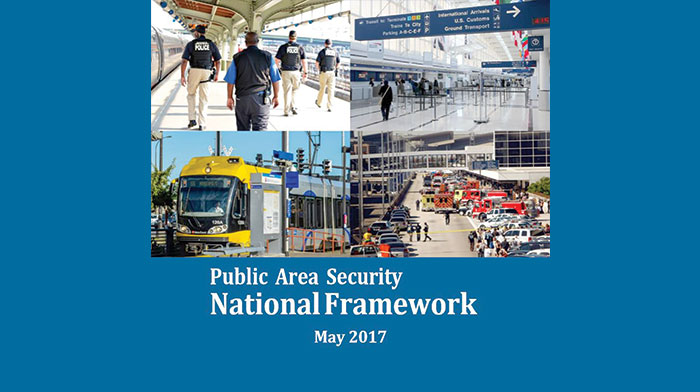Courtesy of TSA
By Michael V. Cusenza
The Transportation Security Administration on Monday announced the publication of the Public Area Security Summit National Framework – a set of recommendations jointly developed with industry, government, academic, international, and public officials that enhance security in public spaces at airports and throughout the transportation system.
According to the TSA, the development of the national framework commenced in mid-September 2016 with the first in a series of Public Area Security Summits, commissioned in response to the atrocities at Brussels International Airport and Istanbul Ataturk Airport, that highlight the evolving tactics and techniques that adversaries use to attack civilian targets in public areas. This threat was further amplified, the agency said, after the Jan. 6, 2017, attack at Ft. Lauderdale International Airport. The group of industry, government, academic, international, and public officials worked together to leverage an entire network of transportation and security officials to devise a framework that deters terrorist attacks and creates a system that quickly and effectively responds to attacks in the public area to minimize loss of life and disruption of transportation.
“In the past, we focused on de-conflicting various security efforts in the public area,” according to the analysis. “Now, with a comprehensive framework, we can align, synchronize, and integrate multiple security-focused agencies and programs that enable the protection of the public area. Each airport or transportation venue will be different, but the approach will be the same. Partnerships informed by awareness of connected efforts throughout the transportation system are the key to success in the public area.”
The 25-page report lists three tenets – Information Sharing, Attack Prevention, Infrastructure & Public Protection – as key to the framework, and details 11 recommendations for handling public safety at transportation hubs within those tenets, including: Cultivate Relationships; Develop Communication Strategies; Enhance Situational Awareness; Expand Threat Awareness Education; Develop Joint Risk Frameworks & Enhance Joint Vulnerability Assessments; Establish Airport Operation Centers; Conduct Background Checks & Threat Assessments of Public Area Workers; Conduct Workforce Employee Training; Develop, Conduct, and Practice Exercises & Response Drills; Invest in Innovative Construction Designs; and Coordinate Response Planning.
Additionally, the analysis delves into the “Way Ahead,” and how to implement framework going forward.
“The partnerships established by the Public Area Security Summits do not cease with this framework,” the report says in its final section. “The group is committed to engaging and collaborating with partners, which includes identifying organizations or individuals who have not traditionally been incorporated into either aviation or other transportation security plans. Meetings will continue, in order to affirm partnerships and continue reviewing solutions to improve public area security. Our work continues.
“As aviation is a global industry, airport stakeholders around the world continue to grapple with the multiple challenges of landside security. DHS, along with industry association partners, plans to create and maintain regular forums for U.S. and international counterparts to communicate and strategize regarding best practices and lessons learned in landside security. Discussions between U.S. and international airport managers are already occurring as a result of the Public Area Security Summits.”

